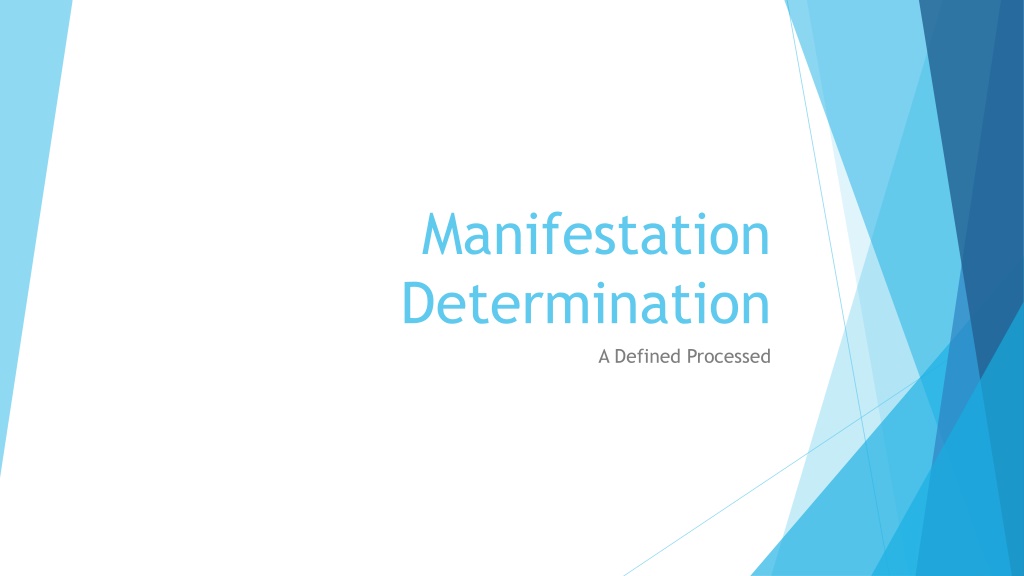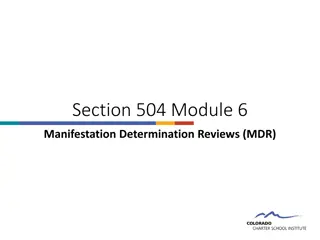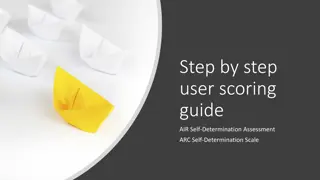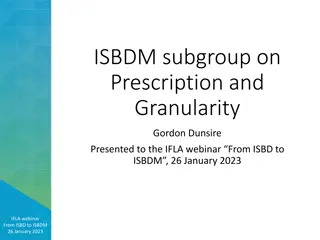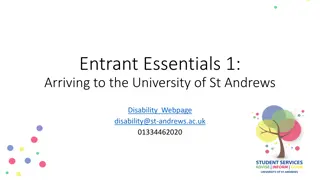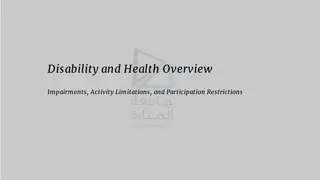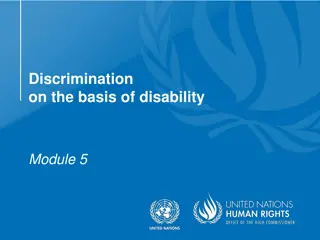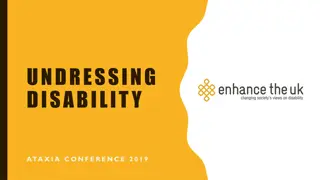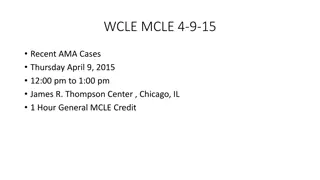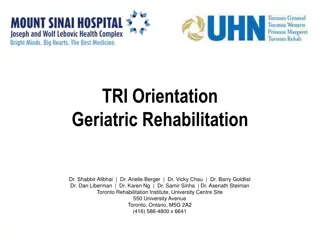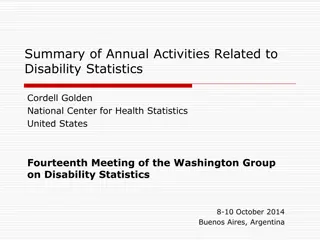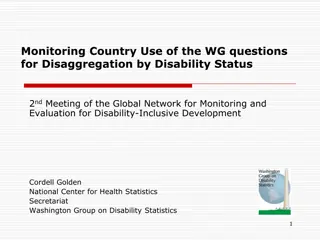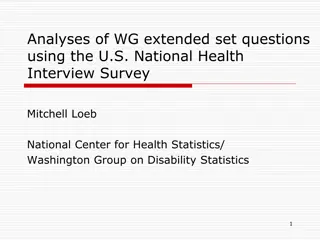Understanding Manifestation Determination in Student Disability Cases
Manifestation Determination is a crucial process within the context of special education that involves determining if a student's behavior issue was a result of their disability. This process necessitates thorough evaluation, consideration of relevant information, and adherence to specific steps during IEP team meetings. Further assessment is required to ascertain the impact of the disability on the student's behavior and to determine appropriate interventions.
Download Presentation

Please find below an Image/Link to download the presentation.
The content on the website is provided AS IS for your information and personal use only. It may not be sold, licensed, or shared on other websites without obtaining consent from the author. Download presentation by click this link. If you encounter any issues during the download, it is possible that the publisher has removed the file from their server.
E N D
Presentation Transcript
Manifestation Determination A Defined Processed
Manifestation Determination Defined "Manifestation Determination" is a process to determine if a student s behavior problem was or was not a manifestation of the student s disability. A Manifestation Determination is completed as part of an IEP team meeting. The IEP team must convene no later than 10 school days when: A parent requests such a meeting following a disciplinary incident. A student is suspended for 5 or more consecutive days. A student is suspended for more than 10 cumulative days in a school (and for every suspension thereafter). A change in placement for more than 10 consecutive days is being sought for disciplinary reasons. Exclusion or expulsion is being considered.
Steps to Consider During The Process 1. Prior to the IEP meeting, information such as evaluation and diagnostic results, observations, current IEP, placement information and other relevant information supplied by the parents must be gathered for review by the IEP team. As part of the discussion, the team must determine if: the information gathered is sufficient information to make the manifest determination. further information is needed in order to make the manifestation determination. there is a need for changes in the student s current special education program. If further information is needed, the IEP team must follow the due process steps in obtaining written parent consent for an evaluation. The IEP team must discuss the characteristics of the student s disability (e.g., withdrawn, aggressive, impulsive, academic or cognitive deficits, information processing, organizational deficits, peer relationships, etc.). This information should come from current data, observation and parent reports as well as from the IEP, evaluations (ESR), teacher reports, discipline records, etc.
Steps to Consider During The Process 2. The IEP team discusses the following questions. If the team is unsure about any of these questions, the behavior is automatically assumed to be a part of the student s disability. If there is disagreement among the team members, the administrator makes the final determination. Are the IEP and placement, supplementary aids and services judged to be appropriate by the IEP team? Initially, this is based on the current IEP. As the discussion progresses, it may be decided that one or the other, or both needs to be changed. Are IEP services and behavioral intervention strategies described on the IEP consistently applied? This is based on the identified needs in the current IEP. * Does the disability impair the student s ability to understand the impact and consequences of the behavior? In addition to the cognitive component, the IEP team should explore the way in which the rules were presented to the student and if they were understood. Consider chronological age, maturity and developmental level.
Steps to Consider During the Process 3. Manifestation Determination If the student s behavior is not a manifestation of his or her disability, the relevant disciplinary procedures applicable to students without disabilities may be applied to the student in the same manner in which they would be applied to students without disabilities. If the behavior is determined to be a part of the disability, the IEP team makes an appropriate plan to address some or all of the following areas (the student may not be expelled from the school system): Consistently implement the IEP as written. Change the IEP as needed (e.g., adaptations, service, alternative consequences, etc.). Complete additional evaluations to provide additional service, if needed. Conduct a Functional Behavior Assessment to develop more effective behavior intervention strategies.
Steps to Consider During The Process continued The District shall notify the parent of the decision to take disciplinary action and of the procedural safeguards no later than the date on which the decision is made. If the parent disagrees with a determination that the student s behavior was not a manifestation of the student s disability, or with any decision regarding placement, the parent has the right to an "expedited" due process hearing. If the District places the student in the allowed interim placement, the "stay put" placement is that setting until its expiration or until the hearing officer s decision, whichever is first.
Case Study #1: Mary is a 9thgrade student who is identified as OHI. During the 3rdmonth of school, Mary got into a fight and was suspended 10 days. Mary returned to school and did not return to the office until the 6thmonth of school for smoking, which is an automatic 3 day suspension. Does the proposed 3 day suspension constitute a change of placement for Mary? Why or Why not? What does IDEA require for Mary as result of the 3 day suspension?
Case Study #1: Ideas & Rationale The total number of days Mary had been removed prior being caught smoking was 10 all students can receive 10-IDEA free days. It had been 3 months since the 10 day removal. The proposed 3 day removal was for a totally different infraction. No change in placement proceed with removal. School personnel along with one teacher of the child determine how services will be provided during 3 day removal. If an FBA/BIP is not in the record the IEP team must convene to establish or review prior to the 11thday of removal.
Case Study #2: Steve is an 11thgrade student identified as BED. Steve is a habitual skipper and within the first 2 months of school had used all 10-IDEA-free days. During the 3rdmonth of school, Steve gets into a fight at a home football game, which automatically is a 10-day suspension. Does the proposed suspension constitute a change in placement? What does IDEA require be done on Steve s behalf?
Case Study #2: Ideas & Rationale Within 2 months Steve had utilized 10-IDEA-free days. The proposed removal is for 10 additional consecutive days which DOES automatically constitute a change in placement. A manifestation determination MUST be completed. If NO Manifestation the student is subject to the same standard as non- disabled students. The IEP team reviews/addends the FBA/BIP and determines where & how services will be delivered during the removal. If it WAS a Manifestation the student cannot be suspended. - The IEP team reviews/addends the FBA/BIP and determines if the current placement is appropriate for the student BE CAUTIOUS!
Case Study #3: Charlie is a 6thgrade student identified as LD. Charlie is the kid in the office every other day and quickly used all 10-IDEA- free days within the first 3 month of school. The following record reflects Charlie s office visits for the 4thmonth: November 2-tardy-1 day suspension (no change in placement determined by school official) November 11-skipping-2 days suspension (no change in placement determined by school official) November 29-disruptive in class-proposed 3 day suspension.
Case Study #3 continued: Does the proposed 3-day suspension constitute a change in placement? Why or Why not? What does IDEA require be done on Charlie s behalf?
Case Study #3: Ideas & Rationale Within 3 months Charlie had utilized all 10-IDEA-free days. The proposed removal is for 3 days BUT there is a clear pattern of removal that does constitute a change in placement. A manifestation determination MUST be completed. If No Manifestation the student is subject to the same standard as non- disabled students. The IEP team reviews/addends the FBA/BIP and determines where & how services will be delivered during the removal. If it WAS a Manifestation the student cannot be suspended. The IEP team reviews/addend the FBA/BIP and determines if the current placement is appropriate for the student BE CAUTIOUS!
Services During Short-Term Removals That Do Not Constitute a Change in Placement In many instances, these short-term removals are for one or two days. We believe that, in these instances, it is reasonable for appropriate school personnel, in consultation with as least one of the teachers of a child, to determine how best to address the child s needs during these relatively brief periods of removal. Pg. 46718 Analysis of Comments & Changes
Services During Short-Term Removals That Do Not Constitute a Change in Placement We believe the extent to which educational services need to be provided and the type of instruction to be provided would depend on the length of the removal, the extent to which the child has been removed previously, and the child s needs and educational goals. Pg. 46717 Analysis of Comments & Changes
Services During Short-Term Removals That Do Not Constitute a Change in Placement For example, a child with a disability who is removed for only a few days and is performing near grade level would not likely need the same level of educational services as a child with a disability who has significant learning difficulties and is performing well below grade level. Pg. 46717 Analysis of Comments & Changes
Services During Short-Term Removals That Do Not Constitute a Change in Placement The ACT is clear that the public agency must provide services to the extent necessary to enable the child to appropriately participate in the general curriculum and appropriately advance toward achieving the goals in the IEP. Pg. 46717 Analysis of Comments & Discussion
Manifestation Determination 2 Prong Manifestation Determination: Within 10 school days of any decision to change the placement of a child with a disability because of a violation of a code of student conduct, the local education agency (LEA), parent and relevant members of the Individualized Education Program (IEP) team (as determined by the parent and LEA) shall review all relevant information in the student s file, including the child s IEP, any teacher observations and any relevant information provided by the parents to determine if conduct was: - Caused by , or was in direct and substantial relationship to, the child s disability; or A direct result of the LEA s failure to implement the IEP. [615(k)(l)(E)(i)]
PLEASE NOTE!!! If found through the manifestation determination process that the LEA had failed to implement the IEP it must take immediate steps to remedy those deficiencies. The BIP is part of the IEP!!!
Determination That the Behavior WAS as Manifestation Either conduct an FBA if one had not been done prior to the behavior and implement a BIP; or If a BIP had been developed, review and modify it, as necessary, to address the behavior. Return the child to their placement prior to removal unless the parent and the LEA agree to change the placement as part of the modification of the BIP.
Determination That the Behavior WAS NOT a Manifestation School personnel may apply the relevant disciplinary procedures to children with disabilities in the same manner and for the same duration as the procedures would be applied to children without disabilities. Services must be provided as to enable the child to continue to participate in the general education curriculum, although in another setting, and to progress toward meeting the goals set out in the child s IEP; and receive, as appropriate, a FBA and behavioral intervention services and modifications, that are designed to address behavior violation so that it does not recur.
Special Circumstances 45 Day Interim Alternative Educational Setting -- Weapon Dangerous Weapon means a weapon, device, instrument, material, or substance, animate or inanimate, that is used for, or is readily capable of causing death or serious bodily injury. The term does not include a pocket knife with a blade of less than 2 inches in length. -- Drugs (Controlled Substances Act) -- Serious Bodily Injury A substantial Risk of Death; Extreme physical pain; Protracted and obvious disfiguration; or Protracted loss or impairment of the fraction of a bodily member, organ, or mental faculty.
Special Circumstances Administrators enforce the 45 day IAES. IEP teams determine the location of the IAES. The LEA may also request a due process hearing if they believe that maintaining the current placement for the child is substantially likely to result in injury to the child or others. Dangerousness Stay-Put in the IAES if parent files for a due process hearing.
Case Study #4: Sandy is a Senior and is identified as EMD. Sandy has not been suspended to this point in the school year. Sandy is caught with a gun on campus. What is the appropriate series of steps administrators can follow and remain compliant with IDEA?
Case Study #4: Ideas & Rationale Sandy can be immediately sent home for the 10-IDEA-free days. Additionally, the principal can order the 45-day IAES. Then IEP team must determine how & where services will be delivered during the IAES placement. Because the infraction is subject to long-term removal, this triggers the need for a manifestation determination.
Case Study #4: Ideas & Rationale If NO Manifestation the student is subject to the same standard a non- disabled students. -- 365 day removal for a gun. -- The IEP team reviews/addends the FBA/BIP and determines where & how services will be delivered during the removal. If it WAS a Manifestation the student cannot be removed. -- Student remains in IAES for 45 days. -- Then the IEP team reviews/addends the FBA/BIP and determines if the current placement is appropriate for the student BE CAUTIOUS!
